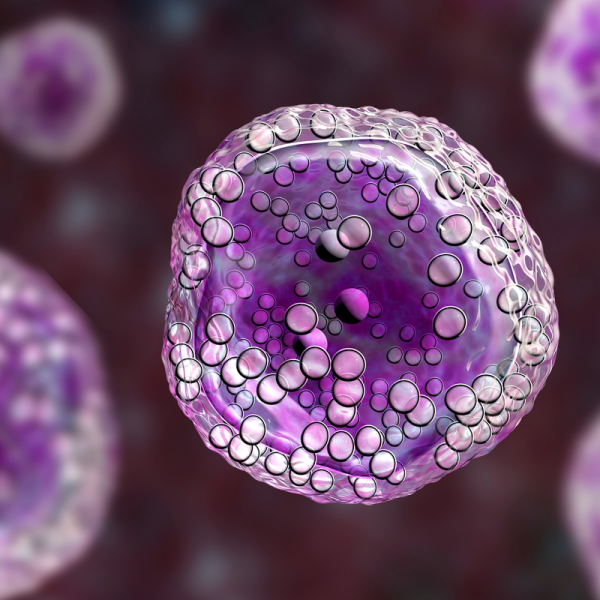
What is Burkitt's lymphoma?
Burkitt's lymphoma bears the name of its discoverer, Dr Denis Burkitt, a tropical physician, and is one of the fastest growing types of tumour. In simple terms, Burkitt's lymphoma can also be described as cancer of the lymph glands or lymph nodes and is assigned to the group of so-called non-Hodgkin's lymphomas. However, Burkitt's lymphoma does not only affect the lymph nodes or the lymph gland, as the term lymph gland or lymph node cancer erroneously suggests. Cells of the lymphatic system as well as organs of the abdominal cavity, such as the kidneys or ovaries, but also the jaw and neck area can be affected. HIV patients suffer from Burkitt's lymphoma with above-average frequency. But Burkitt's lymphoma is also the most common malignant cancer in children in Africa (so-called endemic lymphoma).
How does Burkitt's lymphoma develop?
B-lymphocytes are significantly involved in the development of Burkitt's lymphoma, which is why Burkitt's lymphoma is strictly speaking a B-cell lymphoma. In addition to the B-lymphocytes, the T-lymphocytes also belong to the body's own defence system and are present in the stem cells of the bone marrow. How exactly Burkitt's lymphoma develops, however, is still unknown to doctors. However, they assume that a viral infection, especially the Epstein-Barr virus, as well as chromosomal damage can favour the development of Burkitt's lymphoma.
What are the different types of Burkitt's lymphoma?
Burkitt's lymphoma is divided into the following three types due to the different possible causes of its development:
- endemic Burkitt's lymphoma: The word endemic indicates that this type of disease occurs predominantly in a specific geographical region. For example, endemic Burkitt's lymphoma occurs mainly in Central and East Africa. Endemic Burkitt's lymphoma is one of the most common types of this disease and predominantly affects children and adolescents between 2 and 20 years of age. Boys suffer from Burkitt's lymphoma more often than girls.
- HIV-associated Burkitt's lymphoma: This type of Burkitt's lymphoma occurs mainly in HIV patients.
- Sporadic Burkitt's lymphoma: This type of Burkitt's lymphoma is less common, but occurs worldwide. On average, those affected are ten years older than those with endemic lymphoma.
What are the symptoms of Burkitt's lymphoma?
Burkitt's lymphoma can be recognised by a swelling of the affected area. This is especially visible on the head, which is why many patients visit their doctor. In addition, rather unspecific symptoms such as a drop in performance and lack of interest as well as a general feeling of illness can occur. If the tumour is in the abdominal cavity, it can quickly grow to an enormous size. If, for example, the spleen or liver are affected, patients may suffer from abdominal pain, but also nausea and/or vomiting. If the brain is affected, neurological symptoms such as paralysis and impaired consciousness may appear. Patients also tend to develop bruises easily, as the imbalance of white and red blood cells contributes to clotting disorders.
How is Burkitt's lymphoma diagnosed?
After an anamnesis interview, the doctor will extensively inspect all palpable lymph nodes. In addition, a neurological examination is performed to check the cranial nerves. A cerebrospinal fluid (CSF) examination also plays an important role here. In addition to ultrasound examinations, the doctor can use computer tomography (CT) and magnetic resonance imaging (MRI) to visualise the involvement of internal organs. If a suspicious lymph node is found, a tissue sample is taken and a cytological and histological tissue sample is ordered. In addition, a bone marrow puncture can provide information about whether the bone marrow is affected by the tumour.
How is Burkitt's lymphoma treated?
The first priority with Burkitt's lymphoma should be rapid treatment, as the tumour spreads very quickly, reducing the chances of cure. As a rule, Burkitt's lymphoma is treated with chemotherapy, as the entire body is often already affected by the disease at the time of diagnosis. Chemotherapy is used to kill the cancer cells in the body with cell growth-inhibiting drugs, such as cytostatics. Chemotherapy is given in several treatment cycles, which can last several weeks. The exact duration depends on how the patient responds to the treatment and what effect the therapy has on the tumour. There are longer recovery periods between the treatment cycles.
Chemotherapy can also be given in combination with radiotherapy. Doctors call this radiochemotherapy, which can be used, for example, to reduce the size of the tumour in the abdomen before it is surgically removed.
What is the prognosis for Burkitt's lymphoma?
If Burkitt's lymphoma is diagnosed at an early stage, it can be treated well. Furthermore, the fewer organs that are affected by Burkitt's lymphoma, the better the chances of a cure. Almost 90 percent of all patients are still alive ten years after the successful treatment of Burkitt's lymphoma. However, the tumour often grows again (recurrence), so that treatment is necessary again. In order to detect the recurrence of Burkitt's lymphoma as early as possible, patients should have regular check-ups after successful treatment. Especially in children, i.e. with endemic Burkitt's lymphoma, the prognosis is good.
However, if Burkitt's lymphoma is not treated quickly or remains undetected for a long time, death can occur within a short period of time, which is usually only measured in months. If, on the other hand, several organs are affected by Burkitt's lymphoma, the survival rate drops to less than 50 percent.
